

Thursday, August 29, 2002
![]()
Early Morning Routine
Wildlife researchers always seem to start their day early and Katie and
Caryn are no exception. Most of us were awake by 6:00 AM and anyone who
wasn’t, was awakened by the generator at 6:30. Because we are in the
tropics, sunrise and sunset happen quickly and about the same time each
day. When there is no breeze, the sand flies are relentless.
Aside from assisting with research there are daily chores for which we are
each responsible. There isn’t anyone here to cook or clean for us so
we must do it all ourselves. We have been divided into work teams that rotate
duties over the course of our stay here. There is a cooking team, a cleanup
team, and an equipment team that is responsible for cleaning and storing
the research equipment at the end of each day.
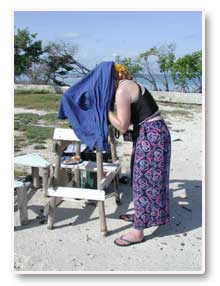 While
Terin and Mike, our cooks for the day, prepared breakfast we made our first
While
Terin and Mike, our cooks for the day, prepared breakfast we made our first
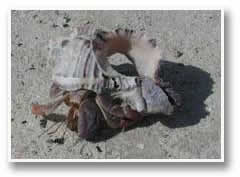 transmission.
Our equipment is very portable and we have set up in all kinds of conditions—rocking
boats, rainstorms, and more times in the dark than we care to remember.
Never though, have we had to contend with overly friendly dogs that in their
jubilance wrapped themselves in the cable connecting the satellite phone
to the antennae. We had visions of them pulling the entire system apart
which would have been the end of our daily transmissions. After bribing
them elsewhere with a few pancakes we were left alone in peace to deal only
with the intense sun and the fiddler crabs that are everywhere! Next time,
we bring an umbrella!
transmission.
Our equipment is very portable and we have set up in all kinds of conditions—rocking
boats, rainstorms, and more times in the dark than we care to remember.
Never though, have we had to contend with overly friendly dogs that in their
jubilance wrapped themselves in the cable connecting the satellite phone
to the antennae. We had visions of them pulling the entire system apart
which would have been the end of our daily transmissions. After bribing
them elsewhere with a few pancakes we were left alone in peace to deal only
with the intense sun and the fiddler crabs that are everywhere! Next time,
we bring an umbrella!
Weather report—No storms in sight!
The first thing Caryn does each morning is listen to the weather report
on the short wave radio. It is the hurricane season and we need to be very
mindful of any storms brewing off shore. The last two years Katie and Caryn
have had to leave the island and seek protection inland as hurricanes and
tropical storms hit the area.
After breakfast Caryn, Katie and Gilroy, their Belizean field assistant,
explained some of the tools and methods we will be using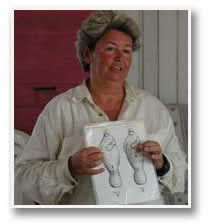 to collect data. They are collecting data on both the manatees and the seagrass.
You may want to review the Research page to understand what questions they
are trying to answer. As we were loading the boat, Caryn said, “If
we are lucky we might see a manatee today.”
to collect data. They are collecting data on both the manatees and the seagrass.
You may want to review the Research page to understand what questions they
are trying to answer. As we were loading the boat, Caryn said, “If
we are lucky we might see a manatee today.”
Once the boat was loaded we headed out into the shallow bay behind the research
station. Normally not all twelve of us will be going out on the boat at
one time. Today and tomorrow though, Caryn and Katie wanted us all to learn
the data collection methods.
Learning the Ropes!
We had two destinations today–Swallow Caye where we hopefully
would observe manatees and an area south of Swallow Caye where we would
learn to sample seagrass.
As we pulled away from the dock, the dogs jumped into the water to swim
along side us. Clearly, they are very comfortable in the water here as they
paddled quite a distance. Within seconds Caryn spotted a manatee! Gilroy
stopped the boat and Caryn jumped into the water with a snorkel, a mask,
and a video camera in a special water protective housing. Every opportunity
she has she attempts to take photos and videos of manatees in the water.
One of the primary ways that researchers identify individual animals is
through photo  identification.
Caryn has a database of manatee images. Many manatees have scars and even
pieces of their tails missing from encounters with boats and fishing gear.
While very unfortunate for the manatees, they serve to help identify individual
manatees.
identification.
Caryn has a database of manatee images. Many manatees have scars and even
pieces of their tails missing from encounters with boats and fishing gear.
While very unfortunate for the manatees, they serve to help identify individual
manatees.
We watched Caryn swim and dive for close to ten minutes. She reported that
there was a feeding scar or a disturbance in the bottom mud indicating that
a manatee or other animal had been rooting in the mud. Because there wasn’t
any seagrass present, the manatees’ primary food, she thought that
it was left by the stingray we saw swimming nearby instead.
Our first stop along the way was a weather stop. Just outside the bay, Shelly
and Krisan recorded air and water temperature and the speed and direction
of the wind. For more information on these tools and the other tools we
will be using take a look at Tools
of the Trade.
It was crowded, cramped, and confusing on the boat as we constantly had
to maneuver around each other to record data. It always seemed like the
equipment we needed was at the opposite end of the boat from where we were
located. Everyone had a sense of humor about it though. Another few days
and maybe we will acquire our “boat sense”. No doubt spending
hours on a small boat along with our dormitory style sleeping will make
us all very familiar with one another.
Once out on the open water Gilroy stopped the boat so that we could watch
a bottlenose dolphin swim nearby. The dolphin  swam
around the boat coming to the surface every few moments to breath. Occasionally
it would dive deep displaying its tail fin. We could see its footprint–the
area on the surface of the water that is slightly disturbed when a marine
animal is close to the surface. It reminded us of the footprints that we
often saw in the Amazon indicating the presence of river dolphins.
swam
around the boat coming to the surface every few moments to breath. Occasionally
it would dive deep displaying its tail fin. We could see its footprint–the
area on the surface of the water that is slightly disturbed when a marine
animal is close to the surface. It reminded us of the footprints that we
often saw in the Amazon indicating the presence of river dolphins.
 Near
Swallow Caye there are signs in the water that alert boaters that they are
entering the Shallow Caye Wildlife Sanctuary. These signs remind boaters
that manatees are present and to slow down. This section of the Belize Barrier
Reef Lagoon system became a marine sanctuary in July 2002. A man named Chocolate
has been working since 1985 to get this section named a sanctuary.
Near
Swallow Caye there are signs in the water that alert boaters that they are
entering the Shallow Caye Wildlife Sanctuary. These signs remind boaters
that manatees are present and to slow down. This section of the Belize Barrier
Reef Lagoon system became a marine sanctuary in July 2002. A man named Chocolate
has been working since 1985 to get this section named a sanctuary.
When we arrived there was a small tourist boat in the study area. The boat
was sitting right in the 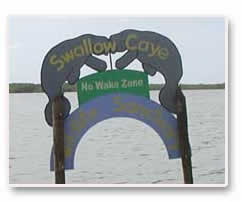 middle
of a manatee-resting hole so we had to wait a bit for it to leave. In Belize,
people are not allowed to swim in areas where manatees are present. Caryn
and Katie have a special permit that gives them permission to swim with
the animals for research purposes.
middle
of a manatee-resting hole so we had to wait a bit for it to leave. In Belize,
people are not allowed to swim in areas where manatees are present. Caryn
and Katie have a special permit that gives them permission to swim with
the animals for research purposes.
Once the boat left, we approached the hole with our engines off. Gilroy
planted a long pole in the mud and we anchored to it. We started our manatee
scan at 11:19 –researchers are exact! While anchored there we saw at
least three manatees in the area! A few times the manatees swam right next
to the boat. We could see at least five white scars on one of the manatee’s
back. At one point there was a mother and her calf near by. From above it
is easy to see how large the animals actually are. One was between eight
and ten feet long. We watched the manatees until they disappeared up a small
creek into the center of the mangroves.
Cooling Off
By this time we had been observing for hours without food
or a bathroom break and were teasing Katie and Caryn about a mutiny if we
didn’t get relief soon! We pulled out the trail mix, oranges and bananas
and consumed them immediately. It was close to a feeding frenzy. Eventually
Gilroy moved the boat to a favorite lunch spot underneath a mangrove tree
where we ate macaroni salad with tortillas. Dehydration is a real possibility
when we are out on the boat in the intense sun and heat so we were encouraged
to drink lots of water.
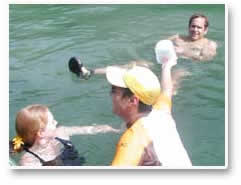 At
the end of lunch some of the team jumped into the water to “cool off”.
This is how the researchers refer to our bathroom stops. Lunch dishes were
tossed in the water to Kevin who had to both rinse them and keep them from
sinking. Of course, this was up current from our “cooling off”
location.
At
the end of lunch some of the team jumped into the water to “cool off”.
This is how the researchers refer to our bathroom stops. Lunch dishes were
tossed in the water to Kevin who had to both rinse them and keep them from
sinking. Of course, this was up current from our “cooling off”
location.
Our next stop was on the other side of Swallow Caye where we did anther
scan. This time we didn’t see any manatees and so we moved on to Bogue
G where we practiced how to sample sea grass. A bogue is local term for
a water channel through mangroves islands. The study area has many of these
bogues and it would be very easy to get lost if one wasn't very familiar
with the area. Thank goodness Gilroy is!
Teaching a group of volunteers who know nothing about manatees or seagrass
to take accurate data is challenging for researchers. We have to be brought
up to speed pretty quickly in order to be of any use during the time we
are here. Consistency and accuracy are large considerations. Katie, Caryn
and Hannah worked closely with us today checking all the data we collected
to ensure that we understood what we were doing and that we were accurate.
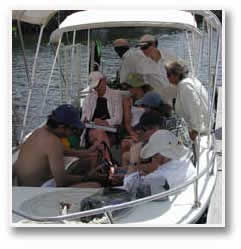
It is one thing to sit on a boat and look for animals in the water. It is
an entirely different thing to be in the water sampling seagrass. Every
task requires making multiple dives to the bottom of the ocean floor (in
this area that is usually somewhere between five and fifteen feet) to count
seagrass plants. Fortunately, enough of the team is quite comfortable using
a snorkel and fins and could actually concentrate on the date collection.
Those of us that weren’t as comfortable performed less demanding tasks
in the boat. Once we are proficient and Katie and Car are confident in our
abilities, we will begin the real task of data collection.
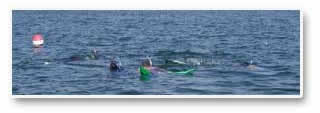 We
spent a few hours in the water practicing our techniques. The water was
as warm as bath water and somewhat clear. Although with so many of us swimming
around the bottom, mud was stirred up a bit making visibility difficult.
Tomorrow we will all go out in the boat again and practice some more with
the hope that we improve our techniques enough to record accurate data.
We
spent a few hours in the water practicing our techniques. The water was
as warm as bath water and somewhat clear. Although with so many of us swimming
around the bottom, mud was stirred up a bit making visibility difficult.
Tomorrow we will all go out in the boat again and practice some more with
the hope that we improve our techniques enough to record accurate data.
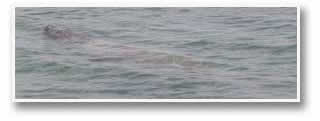 We
returned home at dusk, tired and hungry. Yet today we not only saw manatees
but we even got some pictures of them. It took two years to get a decent
river dolphin photo and we had to go to the zoo to get a Roloway monkey
picture, so we figure we are doing pretty good on this expedition!
We
returned home at dusk, tired and hungry. Yet today we not only saw manatees
but we even got some pictures of them. It took two years to get a decent
river dolphin photo and we had to go to the zoo to get a Roloway monkey
picture, so we figure we are doing pretty good on this expedition!
![]()